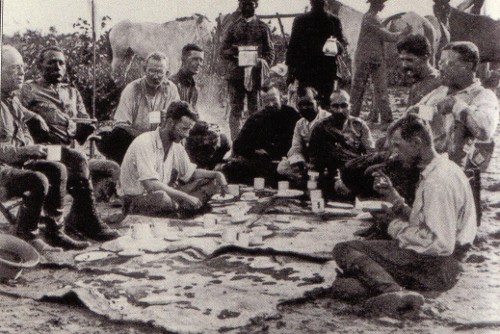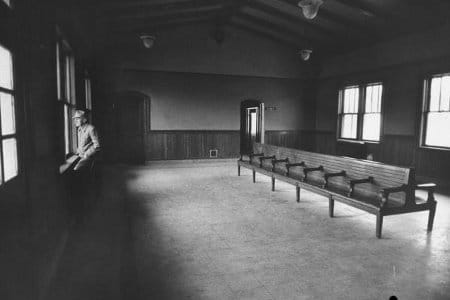
In one of the emails Oliver Burkeman, author of Time Management for Mortals, sent out to his subscribers, he talked about how we typically treat our to-do lists like buckets that we need to empty every day.
The problem, Burkeman observes, is that the to-do list is a bucket that never entirely empties. As we clear some tasks out, others are added in. It’s like the Magic Beer Floating Faucet Fountain that they used to sell at Spencer’s back in 1990, along with black lights and bags of reindeer poop.
Because you treat your to-do list like a bucket that needs emptying before it overflows, you get stressed out by the fact that it nonetheless remains perennially filled. Despite all the evidence to the contrary, you continue to carry the expectation that one day, if you work hard enough or find the right organizational system, you’ll finally get all caught up.
There’s a better alternative to existing in this tense, unsatisfying state of productivity limbo where you constantly feel like you’re failing.
Burkeman argues that if you want to reduce the stress you feel about your to-do list, you need to change the analogy with which you frame it, from a bucket, to a river.
When you go backpacking and stop at a river to fill up your hydration pack, you never think, “I need to capture ALL of this water that’s flowing by me.” That would be 1) impossible, and 2) silly.
Instead, you take what you need and then move on with your hike, not thinking twice about all the water you left behind.
You should treat life’s tasks and chores the very same way.
The Autofocus Method & Its Benefits
Reading Burkeman’s analogy of thinking of your to-do list as a river reminded me of a productivity method I used years ago with great success that treated tackling life’s tasks from a similar perspective.
Developed by writer and productivity expert Mark Forster, it’s called the Autofocus method.
Unlike most to-do list systems, Autofocus does away with categories, due dates, and priorities. You simply create one giant list of tasks (your river) and then work on whatever your focus is naturally drawn to when you review your list. This approach to productivity has several benefits:
It treats your to-do list like the river it is. The Autofocus method accurately approaches your to-do list as a rushing stream that constantly carries in new things in need of doing. You can’t do all of them. The river will never be “done.” So instead of getting overwhelmed by this endless stream of to-dos, you simply dip your hand into the current and tackle the task you think is the right thing to do right now. Rather than worrying (too much) about the other stuff, you go with the flow.
It combines reason and emotion in your decision-making. Forster argues that the Autofocus method combines both the rational and intuitive parts of your mind. You do the right thing that you think and feel needs to be done at that time. The feeling part is important. If you don’t feel like doing something or have the ganas to do it, you likely won’t do it.
If I look at lists I’ve entered into my Todoist, I’ve got several items that I’ve scheduled and prioritized because I rationally told myself that it makes logical sense to do these things on this schedule and at this priority.
But they’ve been on my Todoist for months showing “overdue.” No amount of reason can get me to do those things because there isn’t enough emotion or feeling to move me to do them.
You might be thinking, “But what about something like taxes? No one wants to do taxes, so if you just went by feeling alone in deciding to do your taxes, they’d never get done.”
But in my experience, I haven’t found this to be true. My feelings get plenty stirred as I get closer and closer to the tax deadline. It’s not a positive emotion. It’s basically the fear of getting a penalty from the IRS, but I eventually feel plenty when it comes to my taxes.
It’s the same thing with other jobs, though the motivation can arrive without any rhyme or reason. So it’s true that most days you probably don’t feel like cleaning out the garage. But there likely are times when the urge to do so randomly strikes, and when that urge arises, the Autofocus method will prompt you to ride it.
It encourages little and often work. Autofocus promotes a “little and often” approach to large tasks. With this method, you work on something as long as you want, and if you’re not done with it, you cross it off where it was on the list and add it anew to the bottom of the list. You can work on that thing again when you feel it’s the right time.
Oftentimes, an all-or-nothing approach to doing chores results in doing nothing. With Autofocus, you do a bit at a time until the job is done.
It re-acquaints you with self-trust. It may seem like a “system” as simple as this couldn’t possibly work. That’s because most productivity systems are based on the idea that you can’t trust yourself; their underlying premise is that you’re basically a lazy SOB who won’t get anything done without firm schedules and deadlines. But could it be that you think of yourself that way, and have largely acted in line with that assessment in the past, because you’ve only ever tried to tackle tasks based on external schedules and deadlines? Maybe you’re not a lazy SOB, maybe that’s just not an effective way to work, and you’d actually be more productive if you simply set out to get done whatever it is you feel like getting done each day. Maybe you’d discover you actually do have plenty of impulses to complete tasks once you start regularly prompting yourself to consider what you’re up for doing and let yourself choose what you’d like to work on.
Try trusting yourself that if a task is important, you’ll eventually want to do it. And that if you never want to do it, it may not actually be important.
The paradox around productivity is that the less pressure you feel about how and what you “ought” to be getting done, the more you can actually get done.
How to Use the Autofocus Method
Forster has modified his system over time, but I like the brilliantly simple version that I used back in the day. There isn’t much to it beyond what we’ve already mentioned: create one giant to-do list, look over the list, and do the task that jumps out to you.
But there are a few more bits of structure and strategy that help keep the system moving along; here are Forster’s instructions and more details about how to do it:

Page 1 of a mega master to-do list.
1. Create one long list of everything you have to do or want to do in a notebook. One item per line.
Don’t build a dam in your river of tasks by analyzing each item you put down to determine its priority and then filtering it into an appropriate task channel. That often takes too much work and usually replaces the work of actually getting the things you need to get done, done.
You don’t even need to evaluate whether you should be writing down a task or not. Simply jot down whatever comes to mind, as it comes to mind. With the Autofocus process, items will naturally be culled later on.
The first time you create your list, it might be multiple pages long. That’s okay! Remember, this is a river, not a bucket! You won’t be doing all of these things at once.
2. Read quickly through all the items on the first page without taking action on any of them. You’re just getting a feel of the stream of tasks in front of you.
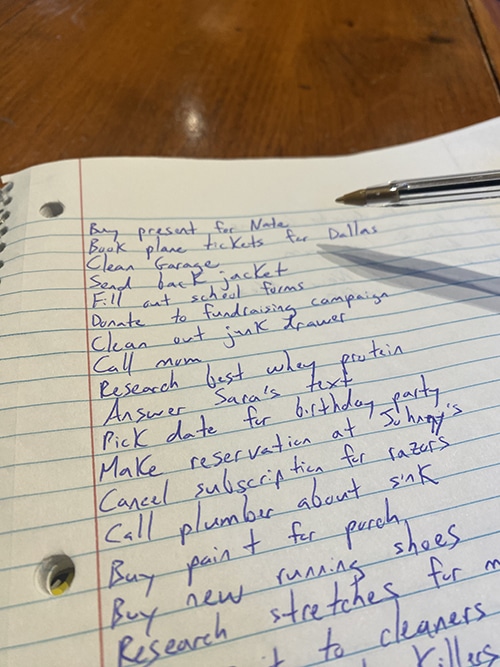
3. Go through the first page again, more slowly this time, looking at the items in order until one stands out for you. Forster says that this is the heart of the system. When you look at an item, you know it stands out when you feel like now is the time to do it. Forster says the feeling is hard to describe but easy to recognize.
4. Work on that item for as long as you feel like doing so.
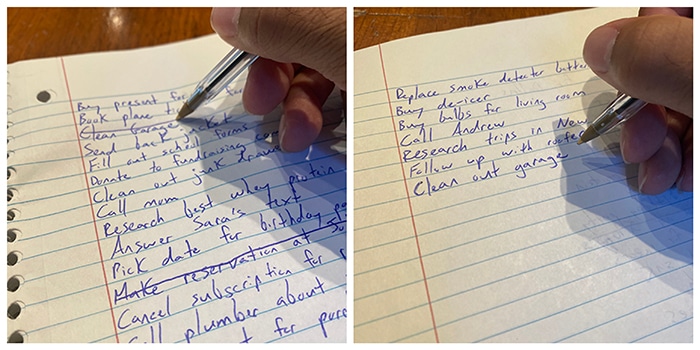
If you begin work on a task, but don’t finish it, cross it off and move it to the bottom of the list (on the second page in this example).
5. Cross the item off the list; re-enter it at the end of the list if you haven’t finished it yet. This is the part of Autofocus that encourages “little and often.” For example, if you have a task to clean the garage, you put it on your list, do it when you feel like it’s the right time, clean for as long as you feel like doing so, and put it back at the bottom of the list if you haven’t finished. You can work on it again when the time is right.
6. Review the list on the first page again in the same way. Don’t move to the second page until you complete a pass of the first page without any item standing out.
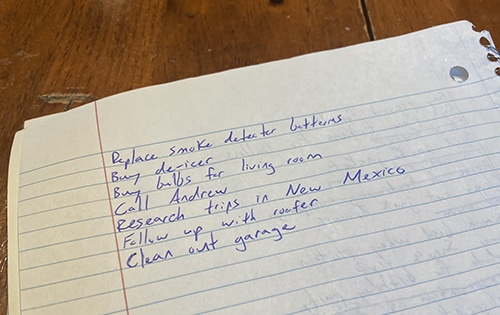
Review page 2 and see if a task jumps out to you.
7. Move on to the next page and repeat the process. Whenever you have time, look at your list to see if there are items you feel prompted to complete. I think regularly looking at the list is a key to success with Autofocus: you don’t generally think about tasks that need doing by default; you have to keep prompting yourself to consider what things you can knock out.
8. Once you’ve finished with the final page, re-start at the first page that is still active. Repeat the process.
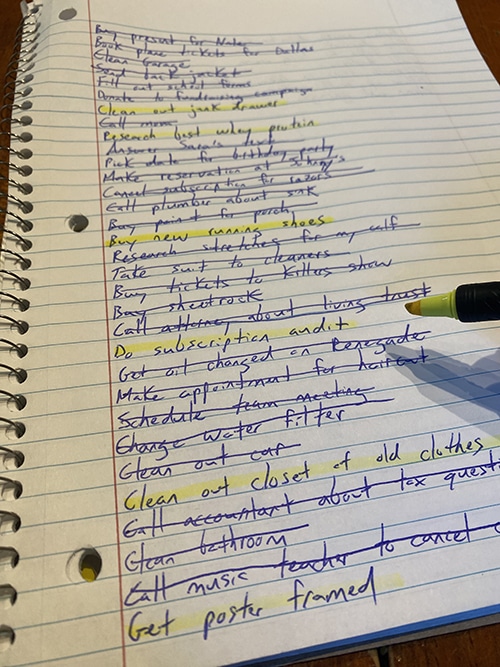
9. If you get to a page and no item stands out for you on your slow pass through it, then all the outstanding items on that page are dismissed without re-entering them. (Unless it’s the last page where you’re still adding new items.)
Use a highlighter to mark dismissed items. This is how you cull items from your river of tasks. Just because you dismissed an item, doesn’t mean it has to be dismissed permanently. Maybe right now it’s not the thing you need to focus on, but in a few months or next year, it might be.
Feel free to revisit dismissed items every now and then to see if you feel like they need to be put back on your active list.

All items on page 1 have either been worked on or dismissed; page 1 has become an inactive page.
10. When all the items on a page in your notebook are crossed out or highlighted, put an X in the top corner to signify that there are no incomplete tasks on this page anymore. The X demarcates an inactive page which no longer needs your attention.
As new to-do’s arise, add them to the end of the list.
That’s it.
As I said, what I like about this method is that it treats your to-do list like the river it is, and it encourages you to combine your reason with intuition so that you do the right thing for right now. Consequently, your to-do list seems less stressful and actually kind of enjoyable to tackle.
Because Autofocus doesn’t rely on dates, it’s essential to combine it with a calendar system so you can account for time-sensitive tasks like appointments and turning in forms at certain deadlines.
For more details about Autofocus, check out Mark’s website. I also highly recommend checking out his several books on productivity. Lots of great big picture insights about combining reason and intuition so you get the essential things done in a way that runs with, instead of against, life’s endless flow.




